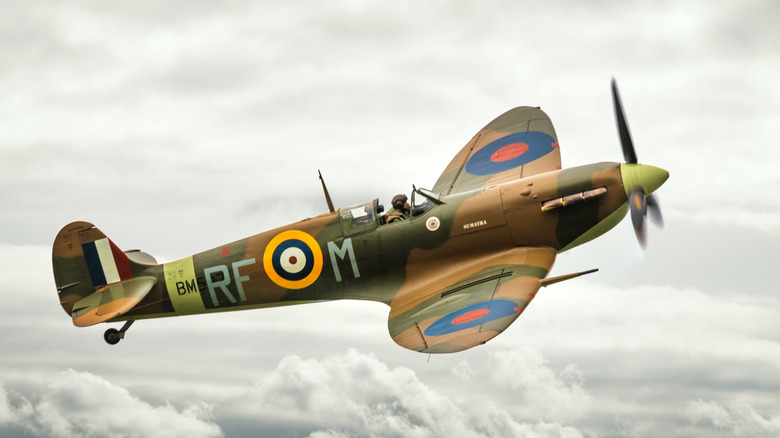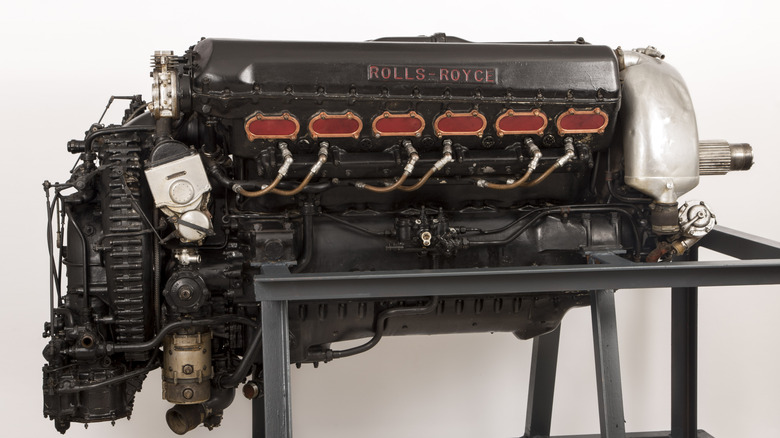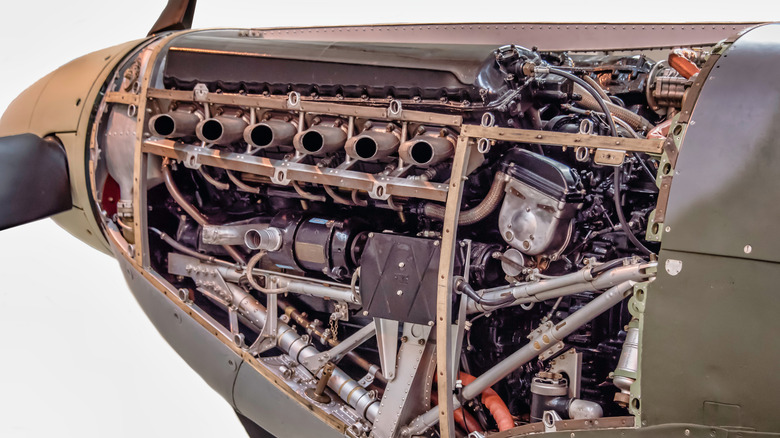What Engine Was In The Legendary Spitfire Fighter Plane?
The Supermarine Spitfire was one of the most innovative WWII planes, earning much respect because of its performance and prowess during key points of the war. Often described as one of the most beautiful aircraft built, its streamlined appearance belies its deadly purpose as a fighter . The Spitfire's success stemmed from a combination of its unique design, such as its elliptical wings and narrow fuselage that gave it great aerodynamics, strong and light construction with a stressed-skin aluminum structure, and the powerplant that made its stellar performance possible, the Rolls-Royce Merlin engine.
Created by Rolls-Royce in the early 1930s, the Merlin engine was an evolution of an earlier Rolls-Royce project called the PV12 –PV meaning private venture and 12 being the number of cylinders – which itself was a development of the Rolls-Royce Kestrel. From the prototype PV-12, Rolls-Royce got to work on the production version, the Merlin I, though the company designation was Merlin F. By 1936, the Fairey Battle became the first aircraft equipped with the new Rolls-Royce engine.
The Royal Air Force recognized the potential of the PV-12, and in 1935, the British Air Ministry released specifications for two new fighters that would leverage the PV-12 engine. The first, designated as F36/34, resulted in the Hawker Hurricane, while the second, called F10/35, created the Supermarine Spitfire. The Rolls-Royce Merlin engine became the perfect fit during World War II, greatly supporting the Spitfire's role.
A great engine made even better
The Merlin's first version in 1933 was only capable of 740 horsepower, but within a few years, its output increased to meet the needs of the new aircraft being built. By the time the Merlin Mk II and Mk III engines were installed in Supermarine Spitfires, the agile fighter had an engine power rating of 1,000 horsepower. Significant improvements to the Merlin engine were made during the duration of World War II to boost power and efficiency. The engine's horsepower increased significantly due to these developments, which later enabled it to power other top WWII fighter aircraft.
By 1936 both the Hurricane and Spitfire went into production. Since the British government was then funding further development of the engine, the PV-12 was no longer a Rolls-Royce private project. The first-generation Merlin engine was soon phased out due to poor performance and was replaced by the Merlin II in 1937, which first went into the Hurricane and the Spitfire. It soon found itself in the Boulton Paul Defiant fighter, as well.
By the end of the war, the continuous development of the engine allowed the Merlin's rated power to more than double, generating 2,300 horsepower. This was a result of engineering and production advancements which included enhancements to its intercoolers and Stanley Hooker's improvements on superchargers that later gave a 70 mph speed boost. Packard Motor Car Company eventually manufactured the engine under license , which the U.S. Army Air Forces used in some of its aircraft.
Legacy of a war-fighting engine
Despite its small size, the Merlin engine was powerful. Its comparably diminutive 27-liter displacement outperformed the 39-liter Daimler-Benz and 42-liter BMW engines used by the Germans. Aside from its wartime contribution, post-war aviation was significantly impacted by the Rolls-Royce Merlin engine that helped win WWII. Many nations created airplane engines that integrated the technologies and the design philosophy of the Merlin.
The Merlin was instrumental to the air superiority of the Allied forces during World War II. Alongside the Spitfire, the P-51 Mustang was also powered by the Merlin and used as a long-range bomber escort to ensure the success of bombing missions. This was made possible because the Merlin supplied the power and fuel economy required to travel great distances at fast speeds.
With over 160,000 engines produced that spawned 50 versions to with 21 different horsepower ratings, as well as production continuing well after the war, the Merlin was one of the most important engines of its time. The legacy of the Merlin isn't limited to the United Kingdom and Europe, as it served in all theaters of World War II. As a machine that helped defend a majority of the world from tyranny, its true value is not measured by its performance in airplanes but by the many times it helped put an end to a terrible conflict.


